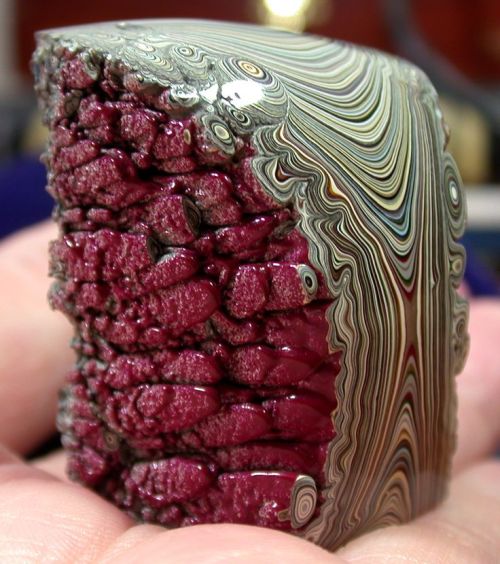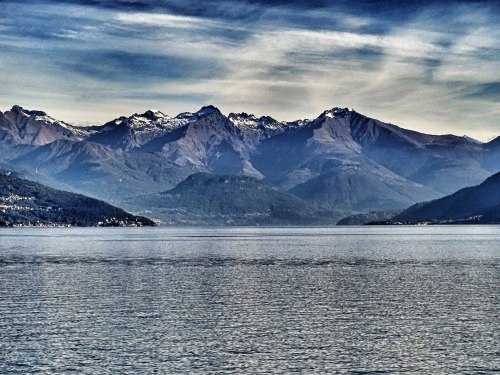Heidi Gustafson, Who Has Spent The Past Five Years Collecting And Working With Ocher, Walks Along Whidbey

Heidi Gustafson, who has spent the past five years collecting and working with ocher, walks along Whidbey Island’s Double Bluff Beach, off the coast of Washington, in search of the material. She came to scout this area, where she spent time as a child, after recalling its interesting cliff exposure.Some ochers, Gustafson believes, are calling out to be turned into a pigment. Others are more resistant. Those ocher fragments are either returned to their point of origin, or, if Gustafson cannot get back there, placed outside in a stone graveyard of sorts that she has created in the forest near her cabin. A few of her ocher-based artworks hang on the wall.
https://www.nytimes.com/2019/10/24/t-magazine/ocher-heidi-gustafson.html
More Posts from Rocks-everywhere and Others

Watling’s Blue Hole
This tiny lake is a feature on the Bahamanian island of San Salvador.
Watling’s blue hole is a karst feature, produced by the erosion of limestone. Limestone is made of calcium carbonate, a mineral that can dissolve in water, particularly in acidic water. Most rainwater is lightly acidic as it picks up CO2 from the atmospere to make carbonic acid; sulfur in the atmosphere can also create stronger acids and acid rain. When it rains on limestone, that little bit of acidity cause the limestone to dissolve, opening a hole or a gap or a low spot in the limestone where more water begins to pool and flow. As the water pools, it concentrates the acidity and dissolves the limestone more rapidly at that spot. The more water that flows into a spot, the more limestone it dissolves - opening up holes in the ground and widening cracks into caves.
Watling’s blue hole has an interesting water chemistry. On small islands, there is interplay between rainwater and seawater – fresh rainwater falls on islands and pushes the denser seawater out of the way, but also leaves mixed, brackish water in-between. Despite sitting on a rainy tropical island like that, Watling’s blue hole has no fresh water anywhere, not even a tiny lens on top, so this hole must link all the way to the ocean to let salt water flow in constantly to dominate the system.
This hole likely formed when sea levels were lower during the last ice age. It would have sat as an open cave at that time, with water draining into it and flowing out to the ocean. Rising sea levels then brought ocean water into that cave, flooding it and creating this blue hole.
-JBB
Image credit: James St. John https://flic.kr/p/q9spdK
Read more: https://www.bgs.ac.uk/mendips/caveskarst/caveform.htm









Watercolour and gouache fossil study and life reconstruction - Elrathia kingii, a very common trilobite from the Wheeler Shale Formation, Utah. Excited to be starting a short course in natural history illustration with @newcastlexnhi this week!
Phlogopite and quartz






Lord of the Rings - The Two Towers | Battle of Helm’s Deep

Fordite, also known as Detroit agate, is old automobile paint which has hardened sufficiently to be cut and polished. It was formed from the built up of layers of enamel paint slag on tracks and skids on which cars were hand spray-painted (a now automated process), which have been baked numerous times.
Obi on Shane Madej’s instastory on April 29, 2019.










happy palentines day, geology edition
bonus

paleontology ones

Blue Morning - Lake Como, Bellagio, Italy
©2019 by John A. Royston - Nosealviewing™ All rights reserved
-
 jumblejo liked this · 3 months ago
jumblejo liked this · 3 months ago -
 digitaloves reblogged this · 3 months ago
digitaloves reblogged this · 3 months ago -
 islandinspace liked this · 3 months ago
islandinspace liked this · 3 months ago -
 fogandfireflies liked this · 10 months ago
fogandfireflies liked this · 10 months ago -
 tiredyeehaw reblogged this · 1 year ago
tiredyeehaw reblogged this · 1 year ago -
 22slices reblogged this · 1 year ago
22slices reblogged this · 1 year ago -
 monolithfarmer reblogged this · 1 year ago
monolithfarmer reblogged this · 1 year ago -
 sweatersandschoolbooks reblogged this · 1 year ago
sweatersandschoolbooks reblogged this · 1 year ago -
 sweatersandschoolbooks liked this · 1 year ago
sweatersandschoolbooks liked this · 1 year ago -
 luarenah reblogged this · 1 year ago
luarenah reblogged this · 1 year ago -
 sacrerouges liked this · 1 year ago
sacrerouges liked this · 1 year ago -
 madrasi reblogged this · 1 year ago
madrasi reblogged this · 1 year ago -
 warmgrey reblogged this · 1 year ago
warmgrey reblogged this · 1 year ago -
 a-greek-gazelle liked this · 1 year ago
a-greek-gazelle liked this · 1 year ago -
 nonsansdroict liked this · 1 year ago
nonsansdroict liked this · 1 year ago -
 letterfromelise reblogged this · 1 year ago
letterfromelise reblogged this · 1 year ago -
 bemybabymp3 liked this · 1 year ago
bemybabymp3 liked this · 1 year ago -
 pixiesnakes reblogged this · 1 year ago
pixiesnakes reblogged this · 1 year ago -
 softskyburial liked this · 1 year ago
softskyburial liked this · 1 year ago -
 indielowercase reblogged this · 1 year ago
indielowercase reblogged this · 1 year ago -
 mac22 reblogged this · 2 years ago
mac22 reblogged this · 2 years ago -
 connor-is-the-captain-of-my-bed liked this · 2 years ago
connor-is-the-captain-of-my-bed liked this · 2 years ago -
 n3ongold3n reblogged this · 2 years ago
n3ongold3n reblogged this · 2 years ago -
 poppetandlocket reblogged this · 2 years ago
poppetandlocket reblogged this · 2 years ago -
 tihaya liked this · 2 years ago
tihaya liked this · 2 years ago -
 tinydropsofperfumedtime reblogged this · 2 years ago
tinydropsofperfumedtime reblogged this · 2 years ago -
 plumcompote reblogged this · 2 years ago
plumcompote reblogged this · 2 years ago -
 dewpointreflection reblogged this · 2 years ago
dewpointreflection reblogged this · 2 years ago -
 lixela reblogged this · 2 years ago
lixela reblogged this · 2 years ago -
 apalatablevastness liked this · 2 years ago
apalatablevastness liked this · 2 years ago -
 fallynleaf reblogged this · 2 years ago
fallynleaf reblogged this · 2 years ago -
 xander-moss liked this · 2 years ago
xander-moss liked this · 2 years ago -
 bewareofdyke reblogged this · 2 years ago
bewareofdyke reblogged this · 2 years ago -
 pied-piper-pluto reblogged this · 2 years ago
pied-piper-pluto reblogged this · 2 years ago -
 bookgeekgrrl liked this · 2 years ago
bookgeekgrrl liked this · 2 years ago -
 stars-inthe-sky liked this · 2 years ago
stars-inthe-sky liked this · 2 years ago -
 village-skeptic reblogged this · 2 years ago
village-skeptic reblogged this · 2 years ago -
 village-skeptic liked this · 2 years ago
village-skeptic liked this · 2 years ago -
 waxedpaperdoor reblogged this · 2 years ago
waxedpaperdoor reblogged this · 2 years ago -
 nothingcompares2u reblogged this · 2 years ago
nothingcompares2u reblogged this · 2 years ago -
 deldon reblogged this · 2 years ago
deldon reblogged this · 2 years ago -
 dataprincess reblogged this · 2 years ago
dataprincess reblogged this · 2 years ago -
 dissforia liked this · 2 years ago
dissforia liked this · 2 years ago -
 the-slow reblogged this · 2 years ago
the-slow reblogged this · 2 years ago -
 primordialfather liked this · 2 years ago
primordialfather liked this · 2 years ago -
 grimdarks reblogged this · 2 years ago
grimdarks reblogged this · 2 years ago -
 silvestrekind reblogged this · 2 years ago
silvestrekind reblogged this · 2 years ago -
 vvormcity reblogged this · 2 years ago
vvormcity reblogged this · 2 years ago
225 posts

